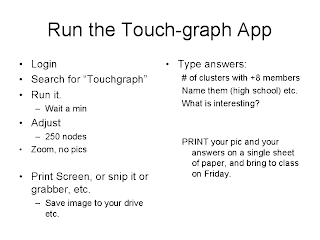Review Conflict Theory
Assumptions
Implications
Examples:
Sports Dynasties: Yankees
The Commons
Shirky
Chapter 4: Publish then Filter
Social tools are only interesting once they get boring
What if our class knew what our class knows?
Chapter 5: Motivation and Collaborative Production
Unmanaged division of labor
Power law distribution
Chapter 6: Collective Action and Institutional Challenges
Ordinary online tools become useful for challenging institutions
2002 example of priest pedophiles
Chapter 7: Faster and Faster
Flash Mobs - ability to coordinate through online means
Groups can organize in a matter of hours, days and weeks
Organization is happening faster and faster
Key Terms
Conflict Theory
Unmanaged division of labor
Power law distribution
Collective action
Flash mobs
Example Questions
How has collective action changed with the implentation of online social tools?
What are the impacts of collective action on large institutions?
Why does publishing then filtering lend itself to collaborative production much more in online environments?
















